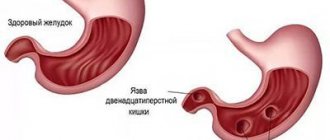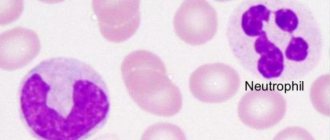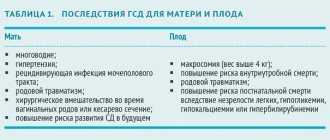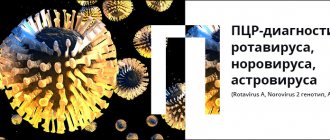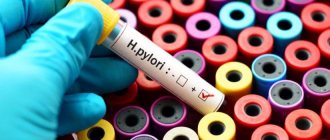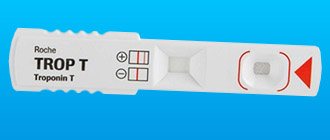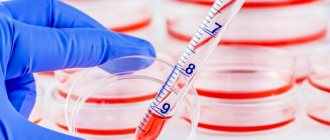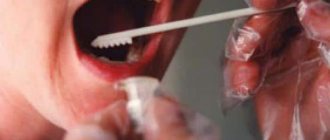DNA analysis for ethnic origin is a real find for people who want to lift the veil of an ancient ancestry and learn more about their roots. A genealogical test allows you to determine a person’s family ties, his ethnic group and the places of residence of his ancestors over the past millennia. Also, the obtained expert opinion can be used in court, government authorities of the EU or the USA.
Depending on the type of test chosen, it can be used to determine:
- A genus haplogroup is a clan with a common genetic marker that has been passed on from generation to generation for thousands of years. Representatives of a common haplogroup in the distant past have the same ancestor. He suffered a point mutation, and all his descendants inherited it. This feature allows you to find out the origin of a person and his ethnicity to a certain group using DNA analysis.
- Ethnic composition in percentage.
- Continent and regions of residence of ancestors, their migration routes.
- Famous personalities belonging to the same family tree.
- The current territories of people who have the same ancestors.
DNA analysis on paternal side
By the Y chromosome, which is transmitted only through the male line, one can find out the ethnic origin of a person through the father. The Y-STR test is used to determine recent ancestry, and SNP to study more distant ancestry. In addition to establishing membership in a particular ethnic group and obtaining interesting information about ancestors, a paternal DNA test makes it possible to check the relationship between men without involving the alleged father.
Paternal DNA testing is carried out only for men and is used for various purposes:
- during adoption – to identify biological parents;
- to resolve legal disputes;
- when conducting forensic examinations;
- to establish close or distant relationships;
- when resolving immigration issues;
- to satisfy my own curiosity.
Women do not have Y chromosomes, so male blood relatives are tested to determine paternal ethnicity.
Half from dad, half from mom
Let's talk a little about theory. If you wish, you can skip this section and move on to the specific examples given below.
Every person, with rare exceptions, has 46 chromosomes
-
44 autosomes
and
2 sex chromosomes
(
X+Y
in men and
X+X
in women).
The exception is sex cells. They contain only 23 chromosomes ,
which is a random combination of genetic material.
In men,
these are 22 autosomes
and one sex chromosome - X or Y
, while
in women they are 22 autosomes and an X chromosome
.
resulting from the fusion of sex cells receives half of the DNA from the mother and half from the father.
.
Transfer of DNA between generations
This is what the concept of “blood relationship” means, but from the point of view of DNA! Taking any cell of our body, we will see that it contains DNA containing fragments of the DNA of the parents. The parents' DNA fragments, in turn, are made up of combinations of their parents' DNA - and so on.
Considering the chromosome sections of the test subjects, we can talk about the presence or absence of kinship. The more identical fragments, the longer they are, the stronger the family connection.
How to pass a DNA test for ethnic origin
To carry out the examination, epithelial cells are used - a saliva sample or a smear taken with a cotton swab from the inside of the cheek. Each cell contains a DNA chain with a unique set of chromosomes. To determine ethnic origin, certain parts of the chain are examined.
To perform a genealogical DNA test for origin, you need to contact a specialized laboratory and submit biomaterial for research. Biosamples can be taken by a clinic specialist or the client himself, using detailed instructions and the received kit for home collection of material. The collected biomaterial can be brought to the laboratory yourself, sent by mail or courier.
Real examples
Enough theory, let's move on to practice. At one time, I did DNA testing for many of my relatives - my mother, father, grandfather's sister, myself, and many others. What do the results look like?
Mother

As you can see in the screenshot, the total DNA between me and my mother is 49.6% (due to the peculiarities of “reading” DNA, this figure does not reach 50%). This is a very significant figure, indicating a clear relationship
. MyHeritage suggested that the person tested was my mother, which is absolutely correct.
24 common segments were also found. These are the same areas on the chromosomes that are almost identical for me and my mother - there may be more of them, fewer of them, they can be longer or shorter.
Dad

I have 23 common segments with my father, not 24, as was the case with my mother - and the largest segment is slightly longer. As you can see, MyHeritage again correctly assumes that my father was found in the matches.
Grandfather's sister

Here is a comparison of my DNA and the DNA of my grandfather's sister. On average , one would expect 25% of the total DNA from a grandfather
.
tested has slightly different DNA fragments from her parents
, so the total DNA is 13%.
In total, the total DNA is as much as 924 cM, which is still a lot. At the same time, the number of fragments has increased - there are as many as 34 of them, but the largest is only 58.5 cM. The further the relationship, the more the common DNA fragments are fragmented.
Once again, MyHeritage correctly guessed that this was my great-aunt.
Second cousin

Let's continue to evaluate the results of DNA testing in relatives. Here we have a comparison of shared DNA with a second cousin. Our common ancestors were born around 1870
! The total DNA is 142 cM - still an impressive number, the number of segments is 9, and the largest segment is 25 cM (which is not too much). This time, MyHeritage cannot give an accurate guess as to who exactly was in the match - and this is understandable, because at such a distance the roulette factor plays an increasingly important role. How was the DNA distributed in each generation, in each specific case, along the path between me and my distant relative? The further the journey, the less accurate the forecast of who is in front of us.
Let's try to find common DNA between even more distant relatives.
Fifth cousin's aunt

DNA testing of my fifth cousin's aunt barely “sees” our relationship. Our common ancestors were born around 1820 - for me that's a full 6 generations ago. Total DNA is only 0.1%, only one common segment, the size of which is 9.5 cM. MyHeritage warns of "low confidence", which means the following:
There is no certainty whether this person with a DNA match is your distant relative or is not related to you at all. This conclusion is based on the small size and number of matching DNA segments.
Thanks to the documents
I know that this is definitely my relative - and
thanks to DNA testing, this documented relationship is confirmed genetically
.
It seems that it is at the level of 5-7 generations that the limit of the search for common fragments on autosomes is outlined. I mentioned above that the transfer of DNA is a roulette wheel, so sometimes the common DNA can be clearly traced at greater depths (some claim that they found common fragments for ancestors who lived in the early 18th century), and sometimes the common fragments are “not visible” even with fourth cousin.
Unknown matches
I ordered DNA testing for myself and my relatives - therefore, in the list of “matches” (people with common DNA fragments), the first, “best” places are occupied by them. I wonder if the test will reveal relatives unknown to me?
Unfortunately, not many people have done DNA testing, especially from the post-Soviet space. But matches can only be with those who passed the test. It doesn't seem like much to expect, but my experience suggests otherwise. For example, my father according to the FamilyTreeDNA
there are 930 matches, of which only the first 4 are known relatives.
MyHeritage
talks about 2724 matches found, there are 96 in the
geni.com
, and finally
gedmatch
shows the first 3000 - it is unknown how many there are in total. Other tested people have approximately the same number of matches.
Despite the huge number of relatives found, identifying who the common ancestor is is often very difficult. Two persons with common DNA fragments must know the pedigree up to the 5th-6th generation along all lines. The task is greatly simplified when both matches have the same surname in their ancestors. Sometimes a common geographic past helps. For example, if the ancestors of both matches lived in the same or neighboring villages, that is where one should look for a common ancestor.
Speaking of matches, I mentioned various bases
.
This is really the problem with DNA testing. When taking tests in one company, you are looking for relatives only among those who also took the test in this company. Fortunately, there is a solution to this problem
-
it is often possible to transfer DNA testing results from one database to another.
There is also a free and very popular resource
gedmatch
, whose main task is to store test results from all companies. I will review various companies and their tests in another post.
All this is interesting. But it’s probably expensive and painful?
Today there are many companies that offer their DNA testing services. The generally recognized leaders in this field are the FamilyTreeDNA
,
23andme
,
Ancestry
,
MyHeritage
and some others. There are also Russian companies offering similar services.
The products of each company have their own specifics, I will write more about this in a separate note. For example, FTDNA offers Y-chromosome and mt-DNA testing, while the main feature of 23andme tests is medical DNA testing. Ancestry historically has the largest database of people tested, and so on.
In recent years, prices for tests have tended to decrease. An autosomal test costs on average $70-80, plus $5-10 for mail delivery of the test. Several times a year, each company offers discounts on a specific range of products - for example, in honor of Mother's Day, discounts on mt tests. On such days, the autosome test is reduced to $59, and on Black Friday in 2021 it was even more expensive 39$
, and delivery was free for a couple of days.
In short, by waiting for Black Friday, you can get the result of your DNA testing at FTDNA for $40
, and taking advantage of other discounts - for $55-65.
Fears that the process of donating DNA itself is something unpleasant are also unfounded. Although each company offers its own method of obtaining DNA, its essence boils down to a simple “spit” in a cone
that was sent by mail, and sending the cone in an envelope back to the laboratory. Of course, this is a very rough approximation - for example, some companies ask you to rub the inside of your cheeks with a cotton pad, which you then put into a cone - but in general it is still the same simple procedure. Detailed instructions for taking the test will be given in a separate note.
Y- and mt-chromosome tests have a wide range of prices, depending on how much detail the chromosome is examined. This is a separate, broad topic that will be described in detail in a separate note.
Medical aspect
Some companies (such as 23andme
) in addition to ethnic origin and relatives, they give a very good medical report based on which genes are present in the DNA.
Despite the fact that the dependence of health, habits, inclinations, susceptibility and non-susceptibility to various substances (for example, caffeine) on genes is still being studied, many results are already reliable.
Diseases
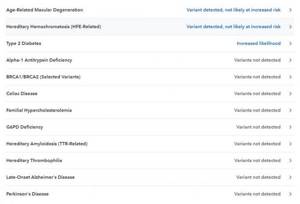
Genes determine the likelihood
diseases of one kind or another.
Thus, type 2 diabetes is partly determined by genetics.
By knowing your weaknesses, you can take steps in advance to avoid problems in the future.
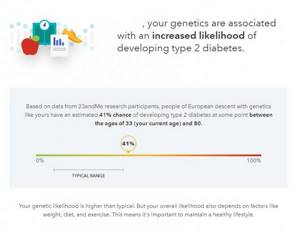
In addition to the unpleasant but important information about the presence of genes responsible for an increased or decreased susceptibility to disease, there is other interesting information.
General health

Reaction to alcohol, caffeine intake, deep sleep, weight, lactose sensitivity and more are all interesting and useful. Of course, you can guess some things without a test. For example, as a teenager, I realized that I shouldn’t drink milk - but this report put everything into perspective - which gene is responsible for susceptibility, and why milk didn’t harm me as a child, and whether I can eat cheese, and much more. . See the images below for more details.
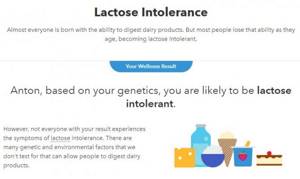
Lactose intolerance
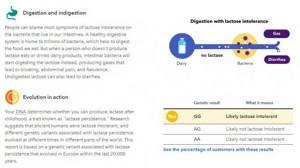
Genes and lactose

Milk in products
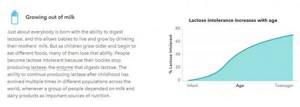
Lactose intolerance depends on age
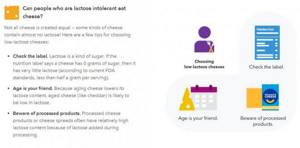
Can you eat cheese?
I did not provide all the medical information
, which can be obtained by testing your DNA. A more detailed analysis will be given in a separate note.
